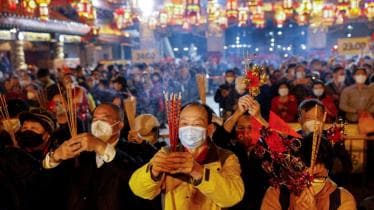Lunar New Year is the beginning of the new year based on the lunisolar Chinese calendar or lunisolar calendar. While lunar calendars follow the lunar phase, lunisolar calendars follow both the lunar phase and the time of the solar year. The event is celebrated by numerous cultures in various ways at diverse dates. Here are some of the most well-known Lunar New Year celebrations across the world:
Losar
Losar, also known as the Tibetan New Year, is a festival in Tibetan Buddhism. The holiday is celebrated on various dates depending on local (Tibet, Bhutan, Nepal, India) tradition. In 2024, the Tibetan New Year commenced on February 10 and celebrations ran until the 12th of the same month. It also commenced the Year of the Male Wood Dragon. The variation of the festival in Nepal is called Lhosar and is observed about eight weeks earlier than the Tibetan Losar. Losar is celebrated for 15 days, with the main celebrations on the first three days. On the first day of Losar, a beverage called changkol is made from chhaang (a Tibetan-Nepali equivalent of beer). The second day of Losar is known as King’s Losar (gyalpo losar). Losar is traditionally preceded by the five-day practice of Vajrakilaya.
Tet
Tet, short for Tet Nguyen Dan (‘Festival of the first day’), is the most important celebration in Vietnamese culture. Tet celebrates the arrival of spring based on the Vietnamese calendar and usually has the date in January or February in the Gregorian calendar. Vietnamese people celebrate Tet annually, which is based on a lunisolar calendar (calculating both the motions of Earth around the Sun and of the Moon around Earth). Tet is generally celebrated on the same day as Chinese New Year (also called Spring Festival), with the one-hour time difference between Vietnam and China resulting in the new moon occurring on different days. This year, Tet fell on February 10.
Seollal
Seollal is a Korean traditional festival and national holiday commemorating the first day of the lunisolar calendar. It is one of the most important traditional holidays for ethnic Koreans, being celebrated in both North Korea and South Korea as well as the Korean diaspora all around the world. During this time, many Koreans would visit their family, perform ancestral rites, wear the hanbok (traditional dress), eat traditional food and play traditional folk games. One of the most well-known practices in the current day is receiving money from their elders after performing a formal bow, a tradition likely adopted from Confucian customs. Seollal generally occurs in January or February on the second new moon after the winter solstice. This year, it fell on February 10.
Ryukyu New Year
Ryukyu New Year is a traditional New Year in the Ryukyu Islands (the Okinawa Prefecture and the Amami Islands in Kagoshima Prefecture, Japan). Japan fully uses the Gregorian calendar after the Meiji Restoration, but the Ryukyu Islands still celebrate the New Year on the first day of the first month of the lunar calendar. The Ryukyu Kingdom first created a calendar based on the Shixian calendar in 1674. The lunar calendar plays a very important role in the fishing-dominated Ryukyu Islands because of the need to rely on the moon’s rise and fall to predict the tides. When the Meiji government implemented the solar calendar, the Ryukyu people who were dissatisfied with Japanese rule continued to use the lunar calendar. Locals eat soba noodles to celebrate the new year, and at the beginning of the new year, each family sends New Year’s cards to each other and a New Year’s gift to the children.
Chinese New Year
The festival celebrates the beginning of a new year on the traditional lunisolar Chinese calendar. Marking the end of winter and the beginning of the spring season, observances traditionally take place from Chinese New Year’s Eve, the evening preceding the first day of the year, to the Lantern Festival, held on the 15th day of the year. The first day of Chinese New Year begins on the new moon that appears between January 21 and February 20. This year, the Chinese New Year fell on February 10. It is also a tradition for every family to thoroughly clean their house, in order to sweep away any ill fortune and to make way for incoming good luck. Another custom is the decoration of windows and doors with red paper-cuts and couplets. Popular themes among these paper-cuts and couplets include good fortune or happiness, wealth, and longevity. Other activities include lighting firecrackers and giving money in red envelopes.
